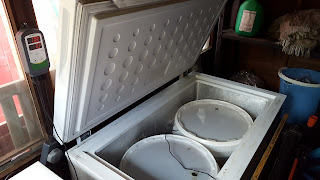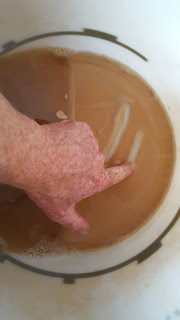Homebrewers tend to think about lagering times in terms of the bare minimum. That’s fair enough – brewing German beer is a huge job, so having an imminent drinking date on the horizon is a good incentive. But what about adding a few extra weeks? Would it help? Would the gratification justify the deferment?
So I brewed a Kölsch in April. Sometime around the end of late June it had had its six weeks lagering and it was ready to go. But it was raining and the sunny weather you really want for a Kölsch was not forecast for the near future. So I brewed another mild, to drink while I was biding my time. In fact, the lagering time the Kölsch got wasn’t hugely over the recommended period. It’s a strong beer, just under 6% - I know, that’s not true to style, I’m calling it an Export Kölsch. If you use the rule of thumb that each degree of ABV requires one week of lagering, then the eight weeks this beer got is not much more than the six it should have had. It felt like longer though. Come mid-July, the weather had really picked up, and I couldn’t resist any longer. Here are the dates:
Brewday: 21 April
Transferred to secondary: 12 May (I know, a slow ferment)
(reduced temperature by 2° per day)
Reached 1° C: 20 May
Kegged: 14 July
SO HOW DID IT TURN OUT?
Short answer, fantastic! You wouldn’t mistake this for a commercial beer, but the clarity is better than almost any other lagered beer I’ve ever made. One concern I had during the lagering was that my fermenting vessels (27L buckets) were not airtight, raising the prospect of oxygen ingress. That would be quite annoying given the huge efforts I go to to keep O2 out of the wort at every stage. Fortunately, it didn’t seem to be a big problem. That said, there were plenty of big malt flavours in there to begin with, so I probably would not have noticed a slight reduction.
The biggest surprise, though, was the sheer quantity of sediment. My fermenting buckets have tapered sides, and that clearly is not ideal for lagering, as a lot of sediment sticks to the sides and then goes back into suspension as I syphon. That was still happening here, but to a much lesser extent. And the sediment at the bottom was astonishing. It was like a yeast cake, up to 1cm deep and quite firm.
Not sure I’ll have the patience to do this again, but the bad news for any brewers as impatient as me is: It definitely is worth adding another week or two to the lagering – it does make a difference.



Good article, just one point of fact, isn't the lagering "rule" one week for every 2 degrees Plato, not ABV? So a 12 Plato beer (1.048), gets six weeks, 14 Plato 7 weeks, etc.
ReplyDeleteI hadn't heard that rule. This beer started at 1.059 (14 Plato), so 8 weeks is still on the generous side.
ReplyDelete2 Things that help me lager: 1) Transfer to and lager in a corny keg, and 2) hide it in the back of a fridge and try to forget about it.
ReplyDelete